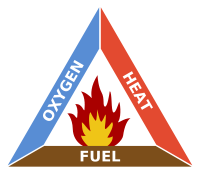
Photo from wikipedia
The heat release rate (HRR) of fuels has been described as the single important variable of fuels in fire hazard, and the HRR experimental measurement remains a key issue in… Click to show full abstract
The heat release rate (HRR) of fuels has been described as the single important variable of fuels in fire hazard, and the HRR experimental measurement remains a key issue in fire science. A modified carbon‐dioxide generation (CDG) method, applying a three‐zone smoke model, is developed to predict the HRR of gas, liquid, and solid fuel fires. The three‐zone smoke model with three layers is determined by the vertical thermal stratification, and their physical thermal properties are computed. The application of modified method on typical gas fuel, liquid fuel, and simple solid‐fuel fires is verified. The prediction accuracy is examined quantitatively by the cosine similarity comparison of predicted results with the experimental data. In addition, the ventilation effects on the predicted results are also explored. Results show that the application of three‐zone model improves the HRR prediction accuracy, because it can accurately capture the mixing behavior from the upper layer to the lower layer. The effect of ventilation on modified CDG method is positive as the ventilation enhances the smoke mixing and the smoke distribution in each layer is relatively uniform.
Journal Title: Fire and Materials
Year Published: 2019
Link to full text (if available)
Share on Social Media: Sign Up to like & get
recommendations!